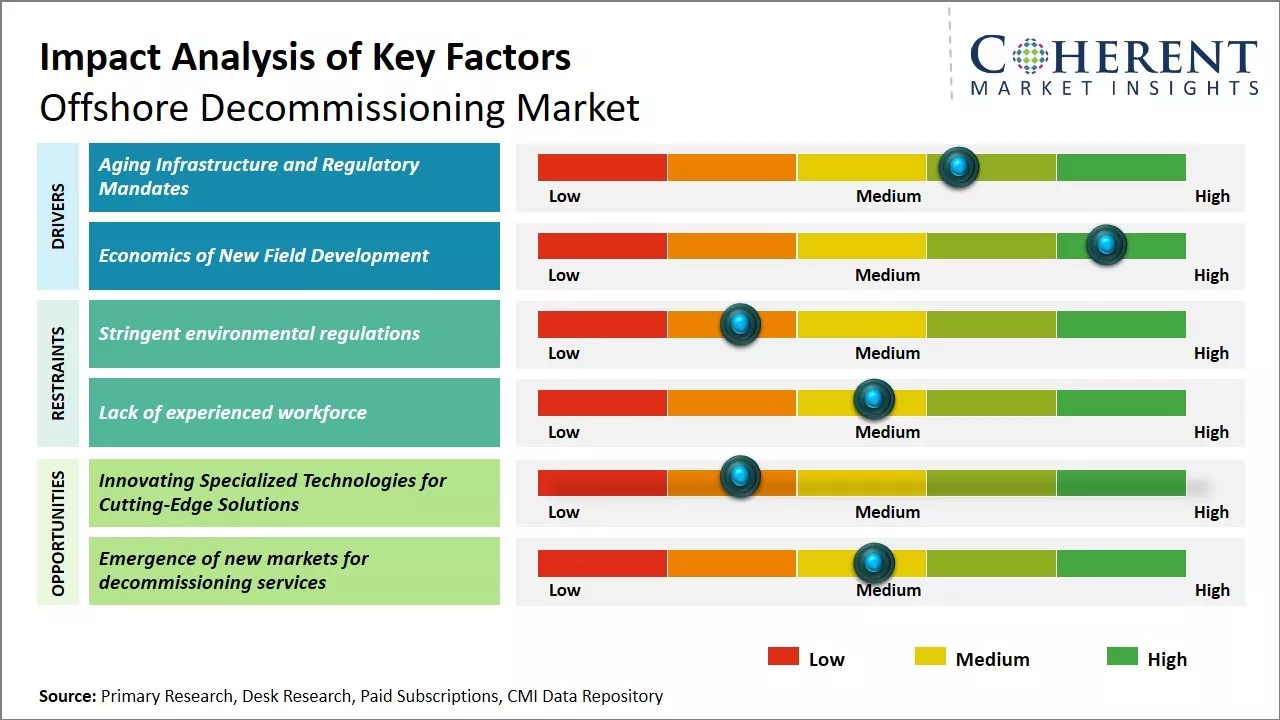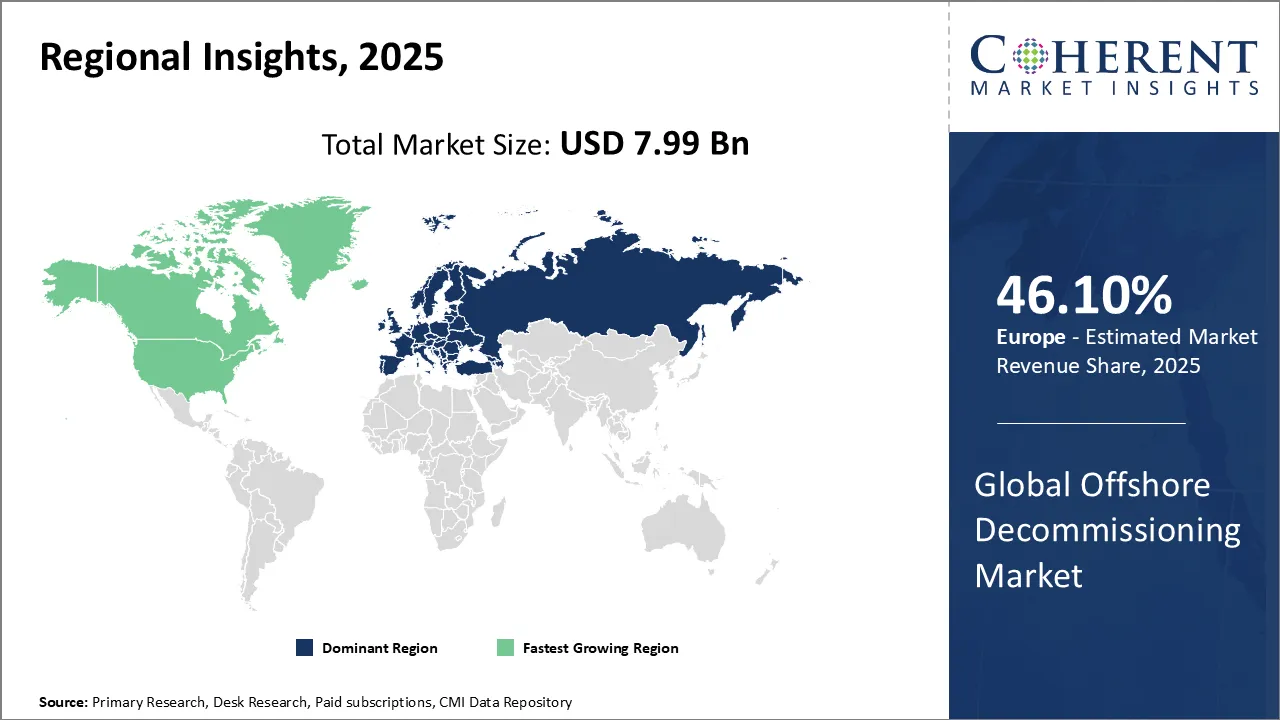The offshore decommissioning market is estimated to be valued at USD 7.99 Bn in 2025 and is expected to reach USD 12.27 Bn by 2032, growing at a compound annual growth rate (CAGR) of 6.3% from 2025 to 2032.

To learn more about this report, Download Free Sample
The global offshore decommissioning market demand is witnessing significant growth, driven by the increasing number of aging offshore oil and gas assets reaching the end of their productive life cycles. Shallow water fields represent a substantial portion of the market due to the large installed asset base requiring decommissioning. Stringent environmental regulations and growing emphasis on minimizing the ecological impact of offshore infrastructure removal are key factors propelling demand for comprehensive decommissioning services.
|
Current Event |
Description and its impact |
|
Regulatory Push for Sustainable Decommissioning |
|
|
Stricter Environmental Regulations and Net-Zero Goals |
|
|
Rise in Global Offshore Platform Retirements |
|
Uncover macros and micros vetted on 75+ parameters: Get instant access to report
Many of the oil and gas fields located offshore. For instance, in the North Sea, were originally developed in the 1970s and 1980s. Much of the infrastructure from that time has now reached the end of its productive life. Pipelines, platforms, and other structures are showing increased signs of corrosion, wear and tear after decades of use in challenging offshore environments.
There is an increasing risk that aging infrastructure could develop leaks or even fail catastrophically if not properly decommissioned. As the original operators look to reduce their commitments and liabilities, they are starting extensive decommissioning programs to remove old facilities. At the same time, regulatory authorities are putting pressure on operators to properly decommission offshore assets according to established guidelines before relinquishing their licenses.
Oil and gas chemical companies are always looking for more profitable reserves to sustain and grow their long-term production levels. With the costs of major new field development projects regularly running into the billions of dollars, operators are increasingly choosy about where they invest their capital.
One of the key evaluation criteria is the ultimate decommissioning liability which will be incurred decades down the line once the field ceases production. Establishing facilities further offshore or in more challenging environments involves higher upfront costs and results in complex decommissioning operations costing hundreds of millions or even billions of dollars. In many cases, the projected decommissioning expenses for a potential new project are simply too high for companies to accept. As a result, marginal or less profitable resources are left undeveloped.
The market size for offshore decommissioning is expected to grow substantially in the coming decades as platforms near the end of production life. This sizable backlog presents opportunities for contractors to develop specialized technologies to solve challenging problems.
The Shallow Water segment is estimated to lead the offshore decommissioning market with a 47.3% share in 2025. This dominance is primarily driven by a vast number of shallow water offshore assets nearing the end of their operational lifecycle. These include aging platforms, offshore pipelines, and infrastructure originally installed in early offshore exploration phases.
The relative ease and lower cost of access, combined with clearer regulatory pathways, further contribute to the preference for shallow water decommissioning activities across key regions such as the North Sea, Gulf of Mexico, and Southeast Asia.
Well Plugging and Abandonment is anticipated to account for a 32.6% share of the offshore decommissioning market in 2025. The segment’s prominence is underpinned by technological advancements in plugging solutions and cementing techniques, which are essential to preventing future leaks and maintaining seabed integrity.
With many wells in aging fields requiring secure abandonment to comply with international safety protocols, this process is gaining increased attention and investment, especially in mature offshore basins.

To learn more about this report, Download Free Sample
Europe is expected to maintain its leadership in the offshore decommissioning market, commanding an impressive 46.1% share in 2025. This regional dominance is largely attributed to the mature offshore oil and gas infrastructure in the North Sea, where numerous platforms and subsea systems are reaching the end of their production lifecycle.
Government-backed initiatives, well-established regulatory frameworks, and the presence of experienced service providers further reinforce Europe’s commanding position in global offshore decommissioning activities. The region also benefits from strong environmental policies and advanced technologies for safe and sustainable decommissioning, making it a benchmark for global standards in this sector.
North America is projected to hold a significant share of the global offshore decommissioning market, supported by the aging oil and gas infrastructure in the Gulf of Mexico. The United States leads regional activities with its stringent environmental regulations, increased focus on liability management, and rising cost pressures for operators. Continued investments in innovative decommissioning technologies and robust project management practices are expected to enhance efficiency and reduce operational risks.
The United Kingdom and Norway dominate Europe’s offshore decommissioning market, which is projected to lead globally with a 46.1% share in 2025. The UK is a pioneer in offshore decommissioning, especially in the North Sea, supported by a comprehensive regulatory framework, extensive infrastructure, and government incentives.
Norway follows closely, leveraging its advanced offshore engineering capabilities, environmental stewardship, and active collaboration between industry stakeholders and regulators. Both countries possess mature oil and gas assets nearing end-of-life and are investing heavily in efficient, sustainable decommissioning practices, reinforcing Europe’s global dominance in this sector.
| Report Coverage | Details | ||
|---|---|---|---|
| Base Year: | 2024 | Market Size in 2025: | USD 7.99 Bn |
| Historical Data for: | 2020 To 2024 | Forecast Period: | 2025 To 2032 |
| Forecast Period 2025 to 2032 CAGR: | 6.3% | 2032 Value Projection: | USD 12.27 Bn |
| Geographies covered: |
|
||
| Segments covered: |
|
||
| Companies covered: |
Acteon Group Limited, Topicus Finan BV, AF Gruppen ASA, Tetra Technologies Inc., Allseas Group S.A., DeepOcean Group Holding B.V., John Wood Group Plc, Exxon Mobil Corporation, Able UK, Aker Solutions ASA, AF Gruppen S.A., John Wood Group PLC, DNV GL, Heerema Marine Contractors (HMC), DeepOcean Group Holding B.V., Royal Boskalis Westminster N.V., Petrofac, and Boskalis |
||
| Growth Drivers: |
|
||
| Restraints & Challenges: |
|
||
Uncover macros and micros vetted on 75+ parameters: Get instant access to report
Share
Share
About Author
Sakshi Suryawanshi is a Research Consultant with 6 years of extensive experience in market research and consulting. She is proficient in market estimation, competitive analysis, and patent analysis. Sakshi excels in identifying market trends and evaluating competitive landscapes to provide actionable insights that drive strategic decision-making. Her expertise helps businesses navigate complex market dynamics and achieve their objectives effectively.
Missing comfort of reading report in your local language? Find your preferred language :
Transform your Strategy with Exclusive Trending Reports :
Frequently Asked Questions
Joining thousands of companies around the world committed to making the Excellent Business Solutions.
View All Our Clients